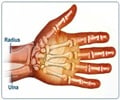- Bone Fractures - (https://www.betterhealth.vic.gov.au/health/conditionsandtreatments/bone-fractures)
Taking care of broken bones
Fractures or broken bones like as is it is usually called are not life- threatening conditions. However, certain first aid measures have to be instituted at the earliest to help the victim. Symptoms include intense pain, swelling, increased pain when trying to move the injured area, feeling of numbness. It can also be accompanied by bleeding in severe cases.
A fracture may not be visible if the skin over the area of fracture is intact. If a broken bone protrudes through the skin surface, it is called an open fracture. Some very common causes of fracture include fall from a height, motor vehicle accidents, and a direct blow to the bone. Fractures in children should raise suspicion of child abuse.
- The initial steps mentioned regarding airway and breathing also hold good while attempting to help a victim with fracture. Appropriate resuscitation and bleeding control are indicated if necessary.
- Try to keep the person still and calm if conscious. Reassure the victim and evaluate for the presence of other injuries.
- Call for medical help and allow the medical personnel to take over if there is an immediate response.
- If the skin is broken, it should be treated immediately to prevent infection.
- If possible, lightly rinse the wound to remove visible dirt or other contamination, but do not vigorously scrub or flush the wound.
- If needed, immobilize the broken bone with a splint or sling. Possible splints include a rolled up newspaper or strips of wood. Immobilize the area both above and below the injured bone.
- Ice packs can be applied to reduce pain and swelling. However, it should not be placed directly over the wound.
- All steps must be taken to prevent shock. Lay the person flat, elevate the feet about 12 inches above the head, and cover the person with a coat or blanket.(6✔ ✔Trusted Source
Bone Fractures
Go to source)








